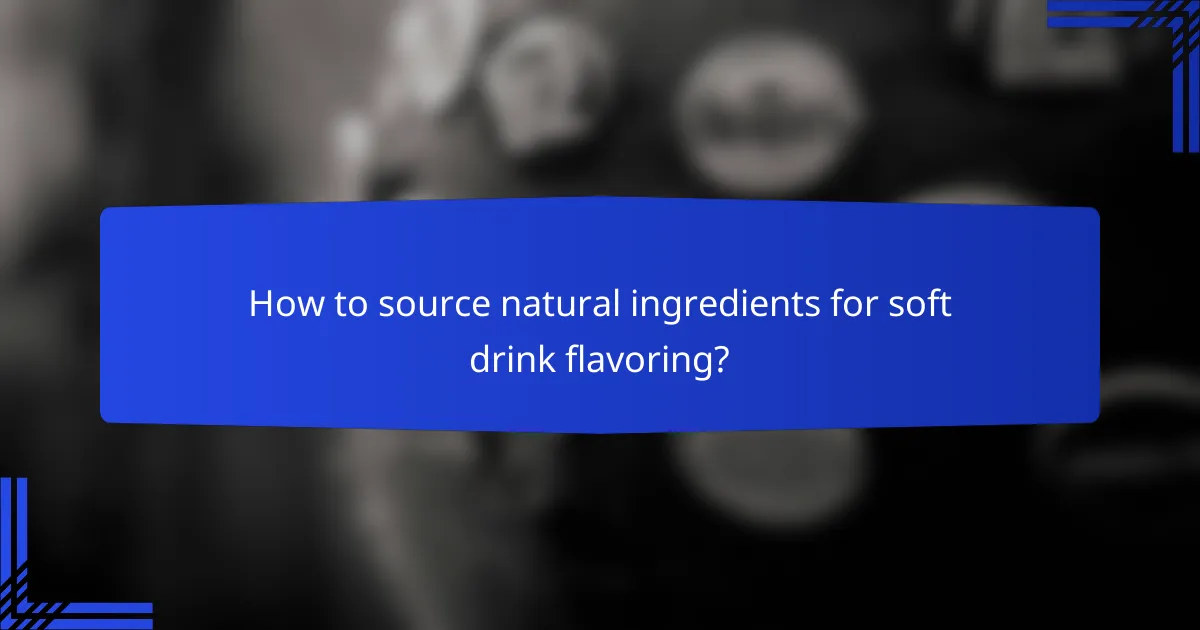Flavoring soft drinks can be achieved through natural or artificial means, each offering distinct advantages. Natural flavorings, such as citrus fruits and herbs, cater to health-conscious consumers, while artificial flavors provide cost efficiency and consistency for manufacturers. Sourcing high-quality ingredients is crucial, whether from local farms or global suppliers, to create appealing and diverse beverage options.

What are the best natural flavoring options for soft drinks in Australia?
The best natural flavoring options for soft drinks in Australia include citrus fruits, herbs and spices, extracts from plants, essential oils, and fruit purees. These ingredients not only enhance the taste but also appeal to consumers seeking healthier beverage choices.
Citrus fruits
Citrus fruits like oranges, lemons, and limes are popular choices for flavoring soft drinks due to their refreshing and tangy profiles. They can be used in various forms, such as fresh juice, zest, or concentrated extracts, providing a vibrant taste that pairs well with carbonated beverages.
When sourcing citrus flavors, consider using locally grown fruits to support Australian agriculture and ensure freshness. Look for organic options to avoid pesticides and enhance the natural flavor.
Herbs and spices
Herbs and spices such as mint, basil, and ginger can add unique and complex flavors to soft drinks. These ingredients can be infused into syrups or used as garnishes, offering a fresh twist that appeals to adventurous consumers.
Experimenting with different combinations can yield interesting results. For instance, a blend of mint and lime can create a refreshing summer drink, while ginger adds warmth and spice to winter beverages.
Extracts from plants
Plant extracts, such as vanilla or almond, provide a rich and aromatic flavor base for soft drinks. These extracts can be derived from various sources, including nuts and seeds, and are often used in small quantities to avoid overpowering the drink.
When selecting extracts, opt for natural versions without artificial additives. This ensures a cleaner taste and aligns with the growing demand for transparency in food and beverage ingredients.
Essential oils
Essential oils can be a potent source of flavor for soft drinks, offering concentrated tastes from various plants. Common options include lemon, peppermint, and eucalyptus oils, which can enhance the overall sensory experience of the beverage.
Use essential oils sparingly, as they are highly concentrated. A few drops can significantly impact the flavor profile, so it’s essential to test and adjust according to taste preferences.
Fruit purees
Fruit purees, made from blended whole fruits, provide both flavor and texture to soft drinks. They can be used to create smoothies or fruit-flavored sodas, adding natural sweetness and nutrients.
When using fruit purees, consider the sugar content and adjust other ingredients accordingly. Fresh or frozen fruits can be blended into purees, allowing for seasonal variations and creative flavor combinations.

What are the advantages of using artificial flavors in soft drinks?
Artificial flavors offer several benefits in soft drink production, including cost savings, consistent taste, and extended shelf life. These advantages make them a popular choice for manufacturers looking to optimize their products.
Cost-effectiveness
Artificial flavors are generally less expensive to produce than natural flavors, which often require extensive sourcing and processing. This cost-effectiveness allows manufacturers to keep prices competitive while maintaining profit margins.
For example, a synthetic flavoring can cost significantly less per liter compared to its natural counterpart, making it an attractive option for large-scale production. This financial advantage can be crucial for budget-conscious brands aiming to maximize their market share.
Consistency in taste
Artificial flavors provide a uniform taste profile that can be replicated across batches, ensuring that consumers receive the same flavor experience every time they purchase a product. This consistency is vital for brand loyalty and customer satisfaction.
Natural flavors can vary due to factors like seasonal changes and ingredient quality, which can lead to fluctuations in taste. By using artificial flavors, companies can eliminate these variables and maintain a reliable product.
Longer shelf life
Artificial flavors typically have a longer shelf life compared to natural flavors, which can degrade over time due to exposure to light, heat, and air. This durability allows soft drinks to remain fresh and flavorful for extended periods, reducing waste and improving inventory management.
For instance, a soft drink with artificial flavoring may retain its intended taste for several months or even years, while a natural flavor might only last a few weeks. This longevity is particularly beneficial for products distributed over large geographic areas.

How to source natural ingredients for soft drink flavoring?
Sourcing natural ingredients for soft drink flavoring involves identifying reliable suppliers who provide high-quality, organic products. Consider local farms, organic suppliers, and global markets to ensure a diverse range of flavors while maintaining quality standards.
Local farms in Australia
Local farms in Australia are an excellent source of fresh, natural ingredients for soft drink flavoring. Many farms specialize in growing fruits, herbs, and botanicals that can be used to create unique flavors. Establishing relationships with these farms can lead to fresher products and potentially lower costs.
When sourcing from local farms, consider visiting them to understand their growing practices and ensure they align with your quality standards. Look for farms that practice sustainable agriculture to enhance the appeal of your soft drinks.
Organic suppliers
Organic suppliers offer a wide range of natural flavoring ingredients that meet strict agricultural standards. These suppliers often provide certifications that guarantee the absence of synthetic pesticides and fertilizers, which is crucial for health-conscious consumers.
When choosing organic suppliers, evaluate their product range, pricing, and delivery options. It’s beneficial to request samples to test the flavors in your soft drink formulations before making larger purchases.
Importing from global markets
Importing natural flavoring ingredients from global markets can expand your options significantly. Countries like Italy and Mexico are known for their unique fruits and spices that can enhance soft drink flavors. However, be mindful of import regulations and potential tariffs that may affect costs.
When importing, establish reliable partnerships with international suppliers and ensure they comply with local food safety standards. This will help avoid issues with quality and legality while providing access to diverse flavor profiles.

What are the blending techniques for flavoring soft drinks?
Blending techniques for flavoring soft drinks involve various methods to combine ingredients effectively, enhancing taste and aroma. Key techniques include cold pressing, infusion methods, and carbonation integration, each offering unique benefits and considerations for flavor development.
Cold pressing
Cold pressing is a technique that extracts flavors from fruits and herbs without applying heat, preserving the natural essence of the ingredients. This method is particularly favored for citrus fruits, where the essential oils from the peel contribute vibrant flavors. It typically involves using a hydraulic press to extract juice, which can then be blended with carbonated water.
When using cold pressing, ensure the ingredients are fresh and of high quality to achieve the best flavor profile. This technique can be more costly due to the equipment and labor involved, but the resulting taste is often superior, appealing to consumers seeking natural flavors.
Infusion methods
Infusion methods involve steeping ingredients in a liquid to extract their flavors over time. Commonly used ingredients include herbs, spices, and dried fruits, which can be infused in water or syrup before blending with carbonated beverages. The infusion time can vary from a few hours to several days, depending on the desired intensity of flavor.
For effective infusion, consider using a temperature-controlled environment to optimize extraction without degrading the ingredients. Straining the mixture afterward ensures a smooth final product, free from solid particles. This method allows for creativity in flavor combinations, enabling unique soft drink offerings.
Carbonation integration
Carbonation integration is the process of combining carbon dioxide with flavored liquids to create effervescence in soft drinks. This can be achieved through forced carbonation, where CO2 is injected into the liquid, or natural carbonation, where fermentation produces bubbles. The choice of method can impact the texture and mouthfeel of the final product.
When integrating carbonation, consider the balance between flavor intensity and fizziness. Too much carbonation can overpower delicate flavors, while too little may result in a flat taste. Experimenting with different carbonation levels can help find the right balance for your specific beverage, enhancing the overall drinking experience.

How do consumer preferences impact flavoring choices?
Consumer preferences significantly influence flavoring choices in soft drinks, as brands strive to meet the demand for both natural and artificial flavors. As health awareness rises, many consumers lean towards beverages that use natural ingredients, prompting manufacturers to adapt their offerings accordingly.
Trends towards health-conscious options
There is a growing trend among consumers favoring health-conscious options in soft drinks, leading to an increased demand for natural flavorings. Ingredients sourced from fruits, herbs, and spices are becoming more popular as they are perceived as healthier alternatives to synthetic flavors.
Brands are responding by reformulating products to include fewer artificial additives and more organic components. For example, beverages sweetened with stevia or flavored with real fruit extracts are gaining traction, appealing to those who prioritize wellness.
To effectively cater to health-conscious consumers, brands should consider transparent labeling and sourcing practices. Highlighting the use of natural ingredients can enhance brand loyalty and attract a broader audience, especially in markets where health trends are prominent, such as in the EU and North America.
